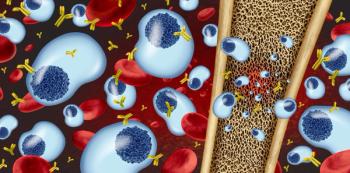
Reducing the Risks: Managing CRS, ICANS, and Skin Reactions in Emerging Lung Cancer Therapies
Key Takeaways
- Tarlatamab-dlle targets DLL3 in SCLC, showing a 40% response rate and notable durability, but requires careful management of CRS and ICANS.
- Amivantamab targets MET and EGFR in NSCLC, demonstrating efficacy but associated with dermatologic toxicities and infusion reactions.
Experts discuss BiTE therapy in treating lung cancers, focusing on innovative agents like tarlatamab and amivantimab, and their toxicity management.
Bispecific T-cell engagers (BiTEs) represent the next generation of off-the-shelf artificial immunotherapeutic agents. They are engineered molecules composed of 2 single-chain variable fragments derived from monoclonal antibodies. One fragment targets a tumor-associated antigen on cancer cells, and the other binds to CD3 on T-cells. These fragments are connected by a nonimmunogenic peptide linker, allowing the BiTE to create an immunological synapse between T-cells and tumor cells, effectively redirecting the immune system to recognize and eliminate cancer cells.1
At the 2025 ASCO Annual Meeting, panelists discussed the novel BiTE agents tarlatamab-dlle (Imdelltra; Amgen Inc) and amivantimab (Rybrevant; Janssen Biotech, Inc) for treatment of small cell lung cancer (SCLC), offering actionable insights about toxicity management, particularly for cytokine release syndrome (CRS) and immune effector cell–associated neurotoxicity syndrome (ICANS).
Tarlatamab-dlle
Tarlatamab-dlle is a first-in-class BiTE that targets DLL3, an atypical delta-like ligand that is low or absent in normal cells but heterogeneously expressed in some cancers. In SCLC, 70% to 80% of tumors have an overexpression of DLL3. Tarlatamab received accelerated approval from the FDA in 2024 for treatment of extensive-stage SCLC that has progressed during or after platinum-based chemotherapy treatment. This decision was based on data from the DELLphi-301 trial (NCT05060016), an open-label, multicenter, multicohort study where tarlatamab treatment yielded an objective response rate of 40%.1,2
“More importantly, the durability of the response was notable, with a median duration of response around 9.7 months, approximately 26% of patients experiencing disease control for over 52 weeks, and a median overall survival of about 15.2 months,” said Abdul Rafeh Naqash, MD, from the Stephenson Cancer Center.1
Tarlatamab is associated with toxicities similar to other oncologic drugs, particularly those used in hematologic malignancies. CRS and ICANs are adverse events (AEs) commonly associated with immunotherapy drugs and are a response to overactivation of T-cells resulting in inflammatory responses. CRS is more prevalent compared with ICANS at a rate of 53% vs 15%, respectively. Additionally, they end to occur early in tarlatmamab treatment.1
“CRS tends to occur early within the first 2 doses of cycle 1, day 1, and the median time to onset to CRS was around 14 hours,” explained Naqash. “In the case of ICANS, most of these occurred within the first 3 months, with the median time to onset of around 30 days.”1
CRS management recommendations include admitting patients for approximately 20 hours of observation following the first 2 doses of therapy. For grade 1 CRS, typically defined by a fever of 100.4 °F or higher, close monitoring is usually sufficient. In cases of grade 2 CRS, it is recommended to initiate treatment with oral or intravenous dexamethasone. If cardiac or respiratory symptoms are present at grade 2, tocilizumab may be considered. ICU transfer is generally reserved for patients who develop grade 3 or higher CRS. Notably, no grade 4 or 5 CRS events were reported in phase 1 and 2 trials.1
For ICANS, it is generally recommended to initiate intravenous steroids when patients develop grade 2 symptoms. Supportive treatment with antiepileptic medications, such as Keppra, may also be used to help manage neurological effects. ICU transfer is typically reserved for patients who reach grade 3 or higher.1
"CRS can cause encephalopathy, which can look a lot like ICANs. But if it's with the first 2 doses, it's unlikely to be true isolated ICANs. Of course, early treatment with IV steroids is the same either way,” said Melinda Laine Hsu, MD, MS, from the University Hospitals Seidman Cancer Center. “And what's the harm in a little Keppra [levetiracetam; UCB Pharmaceuticals S.A.] sprinkled in here or there?"1
One innovative approach that was discussed was prophylactic tocilizumab (Actemra; Genentech), which is commonly used in hematologic malignancies to manage CRS and is effective in preventing it in multiple myeloma. In a small study of 5 patients with high-risk SCLC, prophylactic tocilizumab was associated with no cases of CRS and only 1 case of ICANS. However, tociluzumab is an expensive therapy of which the cost can vary from less than $500 to over $1100 per 10-mg vials. More research needed, ideally through a clinical trial, to confirm effectiveness of prophylactic tocilizumab in preventing CRS for BiTEs in solid tumors.1
“T-cell engagers are likely going to change the treatment landscape with a new class of therapies,” said Hsu. “Managing, understanding, and grading these toxicities is especially important for medical oncologists, and learning from our hematological colleagues who've dealt with these far longer is going to be crucial.”1
Amivantimab
Amivantimab is a bispecific antibody targeting a MET binding domain and an epidermal growth factor receptor (EGFR) binding domain to block ligand-induced activation, induce receptor internalization and degradation, and mediate antibody-dependent cellular cytotoxicity. It was initially approved in 2024 by the FDA in combination with carboplatin and pemetrexed for the first-line treatment of locally advanced or metastatic non–small cell lung cancer (NSCLC) with EGFR exon 20 insertion mutations. This was based on data from the PAPILLON trial (NCT04538664), which reported an overall response rate of 73% with amivantamab, compared with 47% for chemotherapy alone.1,3
The FDA granted amivantamab additional approvals as a first-line treatment of classical EGFR NSCLC and in combination with lazartinib (Lazcluze, Janssen Biotech, Inc) for EGFR exon 19 deletion and L858R mutations. These approvals were supported by data from the MARIPOSA-1 (NCT04487080) and MARIPOSA-2 (NCT04988295) trials.1,4,5
Amivantamab is highly associated with dermatologic toxicities affecting the skin, scalp, and nails, infusion reactions, and venous thromboembolism (VTE).1
Researchers initiated the phase 2, open-label, randomized COCOON trial (NCT06120140) evaluating the effectiveness of COCOON dermatologic management (DM) vs standard of care (SoC) DM in patients with locally advanced or metastatic EGFR-mutated NSCLC receiving first-line treatment with amivantamab and lazertinib.
A total of 138 patients were randomly assigned 1:1 to receive either COCOON DM (n = 70) or SoC DM (n = 68). The COCOON DM regimen included oral doxycycline or minocycline (100 mg twice daily for weeks 1 to 12), clindamycin 1% lotion applied to the scalp (once daily for weeks 13 to 52), daily hand and foot washing with chlorhexidine 4%, and daily application of a noncomedogenic ceramide-based moisturizer to the face and body.6,7
"We could see a significant reduction in the grade 2 or higher dermatologic AES with the enhanced regimen in the standard of care arm. There was an 8.8% risk of grade 3 toxicity in the COCOON regimen,” said Jennifer W. Carlisle, MD, from the Winship Cancer Institute at Emory University. “Results by body location showed a 65% to 70% reduction in the skin and scalp AEs, and a more modest 25% reduction in perinatal."1
Acneiform is also associated with amivantamab, which primarily affects older male patients. This condition typically presents with scattered papulopustules around hair follicles and can progress to more severe symptoms such as progressive crusting, hair matting, pustules, and ulceration. In mild cases, symptoms are limited to scattered papulopustules, but severe presentations can result in extensive scalp ulceration.1
Early referral to a dermatologist is critical, as management strategies depend on the severity of the toxicity. For grade 3 or higher toxicity, treatment may need to be paused or discontinued, as dose reduction alone is often insufficient. In such cases, dermatologists may consider therapies such as oral dapsone, isotretinoin, propranolol, or high-dose systemic or topical steroids.1
Infusion-related reactions (IRRs) are a known concern with amivantamab, occurring in approximately 66% of patients receiving the intravenous (IV) formulation. In contrast, the subcutaneous formulation has shown a significantly lower incidence of IRRs at 13%, along with a notable OS benefit. To mitigate these reactions, the SKIPPirr trial (NCT05663866) explored a prophylactic dexamethasone approach, in which patients received oral dexamethasone 8 mg twice daily on days -2 and -1 prior to infusion.1
This strategy reduced reaction rates to 22%. However, not all patients can tolerate high-dose dexamethasone, highlighting the need for alternative strategies. Although the subcutaneous formulation is not yet approved, ongoing research continues to support its potential benefits.1
VTE is a recognized risk associated with the combination of amivantamab and lazertinib. To reduce this risk, at least 4 months of anticoagulation prophylaxis is recommended during treatment. Certain patient factors may further increase the risk of VTE, including being over the age of 60 and experiencing a positive response to therapy.1
As BiTEs and bispecific antibodies continue to expand the therapeutic landscape for SCLC and NSCLC, clinicians must become adept at anticipating, recognizing, and managing the unique toxicities associated with these agents. Early intervention strategies, prophylactic regimens, and collaboration across disciplines—especially with dermatologists and hematologic oncologists—are crucial to improve safety and optimize patient outcomes. With more research underway and promising data emerging, these off-the-shelf immunotherapies have the potential to redefine standards of care across solid tumors.
REFERENCES
1. Carlisle J, Naqash A, Hsu M, et al. Bispecific T-cell engagers, amivantimab, and the multidimensional impact of toxicity management. 2025 ASCO Annual Meeting. May 30, 2025, to June 3, 2025. Chicago, IL.
2. A phase 2 study of tarlatamab in patients with small cell lung cancer (SCLC) (DeLLphi-301). Updated May 2, 2025. Accessed June 1, 2025. https://clinicaltrials.gov/study/NCT05060016
3. A study of combination amivantamab and carboplatin-pemetrexed therapy, compared with carboplatin-pemetrexed, in participants with advanced or metastatic non-small cell lung cancer characterized by epidermal growth factor receptor (EGFR) Exon 20 Insertions (PAPILLON). Updated May 25, 2025. Accessed June 1, 2025.
4. A Study of Amivantamab and Lazertinib Combination Therapy Versus Osimertinib in Locally Advanced or Metastatic Non-Small Cell Lung Cancer (MARIPOSA). ClinicalTrials.gov identification: NCT04487080. Updated August 12, 2024. Accessed August 20, 2024. https://www.clinicaltrials.gov/study/NCT04487080
5. A study of amivantamab and lazertinib in combination with platinum-based chemotherapy compared with platinum-based chemotherapy in patients with epidermal growth factor receptor (EGFR)-mutated locally advanced or metastatic non- small cell lung cancer after osimertinib failure (MARIPOSA-2). Updated May 25, 2025. Accessed June 1, 2025. https://clinicaltrials.gov/study/NCT04988295
6. Enhanced dermatological care to reduce rash and paronychia in epidermal growth factor receptor (EGRF)-mutated non-small cell lung cancer (NSCLC) treated first-line with amivantamab plus lazertinib (COCOON). Updated April 29, 2025. Accessed May 29, 2025. https://clinicaltrials.gov/study/NCT06120140
7. Gerlach A. Proactive dermatologic care reduces symptom severity and boosts quality of life in NSCLC. Pharmacy Times. May 30, 2025. Accessed June 1, 2025. https://www.pharmacytimes.com/view/proactive-dermatologic-care-reduces-symptom-severity-and-boosts-quality-of-life-in-nsclc
Newsletter
Stay informed on drug updates, treatment guidelines, and pharmacy practice trends—subscribe to Pharmacy Times for weekly clinical insights.




















































































































































































































